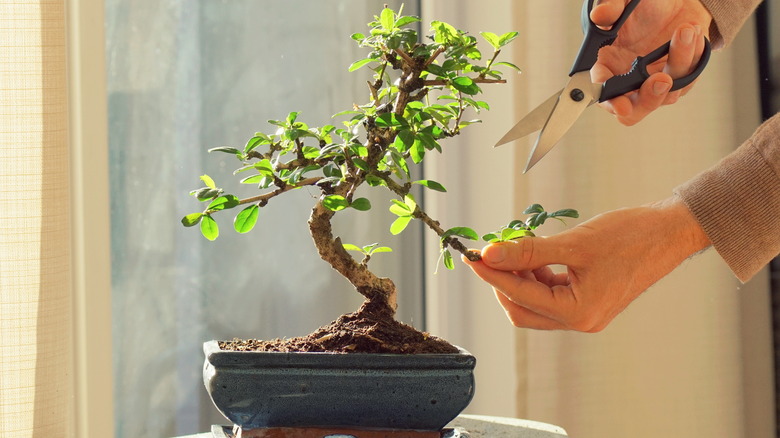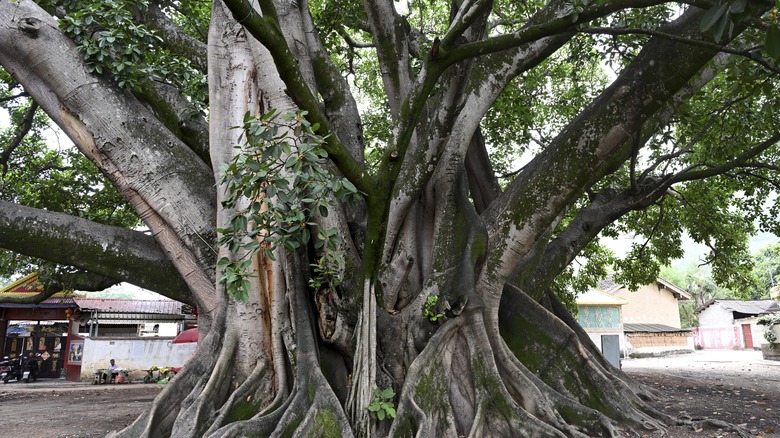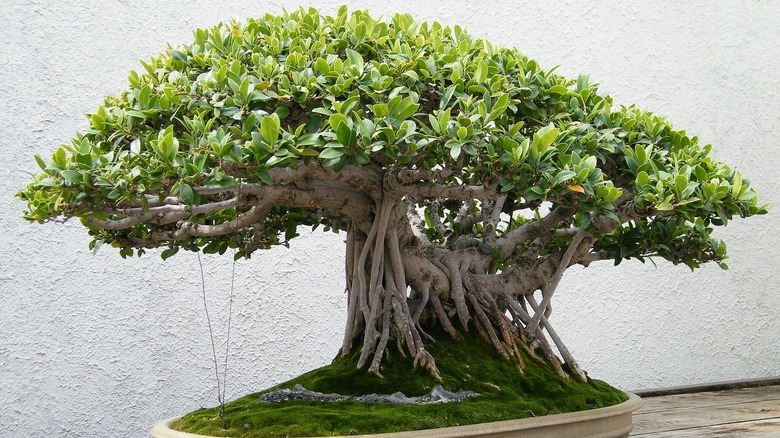The Easiest Bonsai Tree For Beginners That Can Live Indoors Or Outside
Bonsai can be made from just about any long-lived plant that will cooperate, usually a shrub or tree. You'll find bonsai made of juniper, azalea, jade, various Asian pines, figs, Japanese maples, and dozens of others. But the most beginner-friendly species that can deliver truly spectacular results is a member of the tropical Ficus genus called Ficus microcarpa, often referred to as ginseng ficus or Chinese banyan (and sometimes mistakenly called Ficus retusa). Some of the most striking examples of bonsai tree growth and care are trained from Ficus microcarpa, an unusually flexible tropical ficus that can thrive indoors and outside for at least part of the year in many places. It's so hearty and adaptable that, thanks to its aerial roots, this bonsai can be planted and grown in a rock.
Bonsai crafted from Ficus microcarpa is suited for growing indoors because it is tolerant of low light, uneven watering, and low humidity. It also does well in the temperature range you'd commonly find indoors: 70 to 85 degrees, and rarely dipping below 60. Of course, the rigors of becoming a bonsai don't necessarily come easily for houseplants, so ficus benefit from time spent outdoors. For year-round al fresco bonsai-ing, you might get away with growing them outside in hardiness zone 9 or above. But even brief cold can damage the plants, and for bonsai this is particularly undesirable. (As we'll see, you want to save all the damaging for yourself.)
What makes Ficus microcarpa so bonsai-able for beginners?
Left to its own devices, Ficus microcarpa can become a 40-foot tree with fairly large leaves and enough aggression to destroy competitors and even be considered invasive in some tropical areas. How'd it become that civilized houseplant with a little indoor zen garden rake leaning against its shallow tray? It has to do with how resilient Ficus microcarpa is, and how the grower can use that toughness.
Ficus microcarpa's durability makes it easy to keep alive, but that's not the same as coaxing a bonsai from it. A healthy bonsai will keep its leaves and grow more vigorously. And while part of creating bonsai is the systematic removal of leaves and branches, re-growing with vigor is what makes it possible. The standard line for ficus care is to maintain 70 to 85 degrees Fahrenheit, let well-drained soil dry 2 inches deep between waterings, keep it bright without direct sunlight, and feed with a half-strength balanced fertilizer.
But some of these minimal-care axioms must be tossed out if you're going to encourage growth and backbudding — the critical process by which bud growth is encouraged in older wood on a bonsai. Ficus will do better with increased fertilizer and with lots of light and higher humidity levels, which you might be able to manage with windows and misting. The low-maintenance ficus is actually a high-maintenance house plant to avoid if you live a busy life ... at least in its bonsai incarnation.
Zen and the art of Ficus macrocarpa bonsai
Ficus macrocarpa makes this easy in a lot of ways. Folks say nature never created a houseplant, but it came pretty close with this ficus. They tolerate lower light levels indoors by virtue of evolving under a forest canopy;give them bright but indirect light if possible, supplementing window light with LED grow lights if necessary. And while Ficus macrocarpa will do fine in your lower indoor humidity, increasing the local humidity around the plant with frequent spritzes of water can encourage the development of aerial roots. The gift to beginners is that it grows well indoors, but it can also spend the summer outside whenever temperatures stay above 60 degrees, which can ease a lot of processes complicated by growing indoors, like backbudding and aerial root formation.
While Ficus microcarpa can achieve the highest form of the art of bonsai, you still have to put in the work to learn the basics. The bonsai form is forced through processes like defoliation (which encourages reduction in leaf size), ramification (the process of stimulating additional branch growth and creating pads of leaves), aggressive pruning, and backbudding. These are all processes that, it turns out, Ficus microcarpa excels at. If all goes well, its twisted trunk and aerial roots, dense pads of miniaturized leaves, and its cultivated growth "habit" can create the impression of a survivor growing in a wind-swept seaside crag, rather than the product of years or decades of learning and care.


